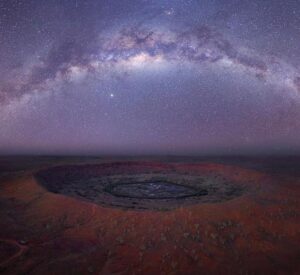The concept of the multiverse has fascinated scientists, philosophers, and science fiction enthusiasts alike. But what exactly is the multiverse, and is there any scientific basis for its existence?
The multiverse theory suggests that our universe is just one of many universes that exist simultaneously. These parallel universes, or “multiverses,” could have different physical laws, constants, and even different versions of ourselves. The idea challenges our understanding of reality and opens up a realm of possibilities that extend beyond our observable universe.
 Pin
Pin Image by Peace,love,happiness from Pixabay
Table of Contents
Inflation Theory
 Pin
Pin Image credit: C. Faucher-Giguère, A. Lidz, and L. Hernquist, Science 319, 5859 (47)
Inflation Theory, proposed by physicist Alan Guth in the early 1980s, is a groundbreaking concept in cosmology that addresses several fundamental questions about the early universe. This theory suggests that a rapid and exponential expansion of the universe occurred just fractions of a second after the Big Bang.
The Basics of Inflation Theory
Inflation theory posits that the universe underwent a period of extremely rapid expansion, known as “inflation,” shortly after the Big Bang. This expansion was driven by a high-energy field, often referred to as the “inflaton field.” During this brief period, the universe expanded exponentially, increasing in size by a factor of at least 10²⁶ in less than 10⁻³² seconds.
-
Exponential Expansion
The hallmark of inflation is its exponential nature. Unlike the slower, linear expansion we observe today, inflation caused the universe to double in size repeatedly in incredibly short intervals.
-
Homogeneity and Isotropy
Inflation explains why the universe appears homogeneous (uniform in composition) and isotropic (the same in all directions) on large scales. The rapid expansion smoothed out any initial irregularities, leading to the uniformity we observe in the cosmic microwave background (CMB) radiation.
-
Flatness Problem and Isotropy
Inflation addresses the "flatness problem," which questions why the universe appears to be geometrically flat. The rapid expansion would have stretched any initial curvature, making the universe appear flat on observable scales.
-
Horizon Problem
The "horizon problem" refers to the question of why distant regions of the universe have similar temperatures and properties, despite being too far apart to have exchanged information or energy. Inflation suggests that these regions were once much closer together before the rapid expansion.
Creation of Multiple Regions of Space-Time
One of the most intriguing implications of inflation theory is the possibility of creating multiple, separate regions of space-time, each evolving into its own universe. This idea is often referred to as “eternal inflation.”
- Eternal Inflation: In some models of inflation, the inflaton field does not decay uniformly across the entire universe. Instead, while some regions stop inflating and form “pocket universes,” other regions continue to inflate. This process can continue indefinitely, leading to the creation of an infinite number of separate universes within a larger multiverse.
- Bubble Universes: Each pocket universe, or “bubble universe,” can have different physical properties and constants, depending on the specific conditions in that region. This could result in a vast and diverse multiverse, with each bubble universe having its own unique characteristics.
Evidence Supporting Inflation Theory
While direct evidence of inflation is challenging to obtain, several observations support the theory:
- Cosmic Microwave Background (CMB): The uniformity and slight fluctuations in the CMB are consistent with predictions made by inflation theory. These fluctuations are believed to be the seeds of all current structures in the universe, such as galaxies and clusters.
- Large-Scale Structure: The distribution of galaxies and large-scale structures in the universe aligns with the patterns expected from inflationary models.
- Gravitational Waves: Inflation predicts the existence of primordial gravitational waves, ripples in space-time that could be detected by future experiments.
Inflation theory, proposed by Alan Guth, has revolutionized our understanding of the early universe and provided a compelling framework for explaining its large-scale structure and uniformity. The idea that inflation could create multiple, separate regions of space-time, each evolving into its own universe, opens up the tantalizing possibility of a multiverse. While much remains to be discovered, inflation theory continues to be a cornerstone of modern cosmology, guiding our quest to understand the origins and nature of the universe.
String Theory
 Pin
Pin Image by Melyna Valle from Unsplash
String Theory is a theoretical framework in physics that seeks to reconcile quantum mechanics and general relativity, two pillars of modern physics that are currently incompatible. This theory posits that the fundamental particles of the universe are not point-like, as traditionally thought, but rather one-dimensional “strings.” These strings can vibrate at different frequencies, and their vibrations determine the properties of particles.
The Basics of String Theory
-
One-Dimensional Strings
Unlike the point-like particles in the Standard Model of particle physics, string theory proposes that the most basic building blocks of the universe are tiny, one-dimensional strings. These strings can be open (with two endpoints) or closed (forming a loop).
-
Vibrational Modes
The different vibrational modes of these strings correspond to different particles. For example, a string vibrating in one way might represent an electron, while a different vibration could represent a quark. This idea unifies all particles and forces under a single theoretical framework.
-
Supersymmetry
String theory often incorporates the concept of supersymmetry, which posits that every particle has a superpartner with different spin properties. Supersymmetry helps to solve several theoretical problems and is a key feature of many string theory models.
Multiple Dimensions
One of the most fascinating aspects of string theory is its requirement for additional spatial dimensions beyond the familiar three dimensions of space and one dimension of time.
- Extra Dimensions: String theory suggests that there are up to 10 or 11 dimensions, depending on the specific model. These extra dimensions are compactified, meaning they are curled up so tightly that they are not observable at everyday scales.
- Calabi-Yau Manifolds: The shape and size of these extra dimensions are described by complex mathematical structures known as Calabi-Yau manifolds. The specific geometry of these manifolds determines the properties of particles and forces in our universe.
Implications for Multiple Universes
String theory opens up the possibility of a multiverse, a collection of multiple, potentially infinite, universes.
- Landscape of Vacua: String theory predicts a vast “landscape” of possible vacuum states, each corresponding to a different set of physical laws and constants. This landscape could give rise to a multitude of universes, each with its own unique properties.
- Brane Cosmology: In some string theory models, our universe is a three-dimensional “brane” floating in a higher-dimensional space. Other branes could exist parallel to ours, each representing a different universe with its own distinct characteristics.
- Cosmic Inflation and Multiverse: The concept of eternal inflation, combined with string theory, suggests that different regions of space-time could inflate at different rates, leading to the creation of separate universes within a larger multiverse framework.
Challenges and Criticisms
While string theory is a promising and elegant framework, it faces several challenges and criticisms:
- Lack of Experimental Evidence: One of the main criticisms of string theory is the lack of direct experimental evidence. The energy scales required to test string theory predictions are far beyond the reach of current technology.
- Mathematical Complexity: The mathematical complexity of string theory makes it difficult to derive concrete predictions that can be tested experimentally.
- Landscape Problem: The vast number of possible vacuum states in string theory’s landscape makes it challenging to predict which vacuum corresponds to our universe, leading to concerns about the theory’s predictive power.
String theory represents a bold and ambitious attempt to unify all fundamental forces and particles under a single theoretical framework. By proposing that the fundamental constituents of the universe are one-dimensional strings, it opens up the possibility of multiple dimensions and a vast multiverse. While the theory faces significant challenges and remains unproven, it continues to inspire and guide physicists in their quest to understand the deepest mysteries of the cosmos.
Quantum Mechanics
 Pin
Pin Image by Garik Barseghyan from Pixabay
Quantum mechanics, the branch of physics that deals with the behavior of particles at the smallest scales, has given rise to several interpretations that attempt to explain the strange and counterintuitive nature of the quantum world. One of the most intriguing and controversial interpretations is the Many-Worlds Interpretation (MWI), proposed by physicist Hugh Everett in 1957. This interpretation suggests that every quantum event spawns a new universe, where all possible outcomes of the event actually occur, each in its own separate universe. Let’s explore this fascinating concept in detail.
The Basics of Quantum Mechanics
-
Wave-Particle Duality
Particles, such as electrons and photons, exhibit both wave-like and particle-like properties. This duality is a cornerstone of quantum mechanics.
-
Superposition
A quantum system can exist in multiple states simultaneously. For example, an electron can be in a superposition of being in two different places at once.
-
Quantum Entanglement
When particles become entangled, the state of one particle is instantaneously correlated with the state of another, regardless of the distance between them.
-
Measurement Problem
The act of measuring a quantum system forces it to "collapse" from a superposition of states into a single state. This collapse is a central mystery in quantum mechanics.
The Many-Worlds Interpretation
The Many-Worlds Interpretation offers a radical solution to the measurement problem by eliminating the need for wavefunction collapse. Instead, it posits that all possible outcomes of a quantum event occur, each in its own separate universe.
- Branching Universes: According to MWI, every time a quantum event with multiple possible outcomes occurs, the universe splits into multiple branches. Each branch represents a different outcome, and all branches exist simultaneously but do not interact with each other.
- Parallel Realities: In this view, there are countless parallel realities, each corresponding to a different sequence of events. For example, if a quantum event has two possible outcomes, the universe splits into two branches, one for each outcome.
- Observer’s Perspective: From the perspective of an observer, they experience only one outcome of a quantum event. However, in another branch of the universe, a different version of the observer experiences a different outcome.
Implications of the Many-Worlds Interpretation
- Determinism and Free Will: MWI suggests that all possible outcomes are realized, which raises questions about determinism and free will. If every possible choice leads to a different branch of the universe, what does this mean for our sense of agency?
- Quantum Computing: The concept of parallel universes has inspired ideas in quantum computing. Quantum computers leverage superposition and entanglement to perform many calculations simultaneously, potentially solving complex problems more efficiently than classical computers.
- Philosophical and Ethical Considerations: The existence of multiple universes with different versions of ourselves challenges our notions of identity, morality, and the uniqueness of our experiences.
Evidence and Criticisms
While the Many-Worlds Interpretation is mathematically consistent with quantum mechanics, it remains a topic of debate among physicists and philosophers:
- Lack of Direct Evidence: There is currently no direct experimental evidence for the existence of parallel universes. The interpretation is based on theoretical considerations and the mathematical formalism of quantum mechanics.
- Occam’s Razor: Critics argue that MWI violates the principle of Occam’s Razor, which states that the simplest explanation is usually the correct one. The idea of countless parallel universes is seen by some as unnecessarily complex.
- Alternative Interpretations: Other interpretations of quantum mechanics, such as the Copenhagen Interpretation and the De Broglie-Bohm theory, offer different explanations for the behavior of quantum systems without invoking multiple universes.
The Many-Worlds Interpretation of quantum mechanics, proposed by Hugh Everett, presents a bold and imaginative view of reality where every quantum event spawns a new universe. While it remains a controversial and unproven theory, it has inspired significant discussion and exploration in both physics and philosophy. As our understanding of quantum mechanics continues to evolve, the Many-Worlds Interpretation remains a fascinating and thought-provoking possibility in the quest to comprehend the true nature of the universe.
While the existence of the multiverse remains unproven, the scientific theories and indirect evidence supporting it make it a compelling possibility. As our understanding of the universe continues to evolve, the multiverse hypothesis remains an exciting frontier in the quest to comprehend the nature of reality.
FAQs: Do Multiverse Exist in Real Life? Exploring the Possibility of Multiple Realities
The multiverse theory suggests that our universe is just one of many universes that exist simultaneously. These parallel universes, or “multiverses,” could have different physical laws, constants, and even different versions of ourselves.
Several scientific theories support the multiverse hypothesis, including:
- Inflation Theory: Proposes that rapid expansion after the Big Bang could create multiple, separate regions of space-time.
- String Theory: Suggests that fundamental particles are one-dimensional strings, allowing for multiple dimensions and potentially multiple universes.
- Quantum Mechanics: The many-worlds interpretation posits that every quantum event spawns a new universe, where all possible outcomes occur in separate universes.
While direct evidence is lacking, some indirect observations support the multiverse theory:
- Cosmic Microwave Background (CMB): Variations in the CMB could hint at interactions between our universe and others.
- Mathematical Consistency: Theoretical models like string theory and inflation theory are consistent with the existence of multiple universes.
- Fine-Tuning Problem: The precise conditions required for life in our universe could be explained by the existence of many universes with different physical constants.
Inflation theory, proposed by Alan Guth, suggests that the rapid expansion of the universe after the Big Bang could create multiple, separate regions of space-time. These regions could evolve into their own distinct universes, contributing to the idea of a multiverse.
The many-worlds interpretation, proposed by Hugh Everett, suggests that every quantum event spawns a new universe. In this view, all possible outcomes of a quantum event actually occur, each in its own separate universe, leading to a vast number of parallel realities.
The multiverse theory challenges our understanding of reality, free will, and the uniqueness of our existence. It raises questions about identity and purpose if multiple versions of ourselves exist in parallel universes.
Yes, the multiverse theory faces several criticisms:
- Lack of Direct Evidence: There is no direct experimental evidence for the existence of multiple universes.
- Occam’s Razor: Critics argue that the theory is unnecessarily complex and violates the principle of Occam’s Razor, which favors simpler explanations.
- Predictive Power: The vast number of possible universes makes it challenging to predict which one corresponds to our reality.
String theory posits that the fundamental particles of the universe are one-dimensional strings, which allows for the existence of multiple dimensions. These extra dimensions could give rise to different universes with unique physical properties, supporting the multiverse concept.
Eternal inflation is a model within inflation theory where different regions of space-time continue to inflate at different rates. This process can create an infinite number of separate universes within a larger multiverse framework.
The multiverse theory expands our understanding of the universe by suggesting that our observable universe is just one of many. It opens up new possibilities for the nature of reality and encourages further exploration and study in cosmology and quantum physics.


































